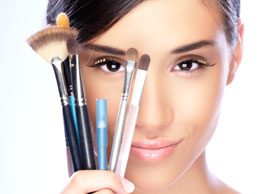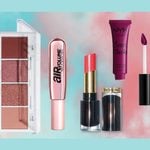The truth about silicones
Silicones play a major role in our cosmetics and personal care products. So why are some companies opting not to use them?

Source: Best Health Magazine, September 2012; Photo credit: iStockphoto.com
We all love silky, shiny hair, and makeup that will stay put even when we work up a sweat. The synthetic ingredient that’s responsible for those results is usually silicone. First introduced to beauty products in the 1950s, silicones are derived from a natural product called silica (basic sand), but undergo extensive chemical processing before being added to our beauty products.
Silicones go by different names (dimethicone is one of the best-known) and are modified into numerous different formulas in order to perform the specific role expected of them’waterproofing, retaining moisture, adhering colour pigments, protecting our hair and imparting smoothness, and making the application of skincare products feel silky’no tugging on the skin as it is spread on, and no oily, sticky feeling. They give our deodorants that velvety feel, allowing them to dry quickly, and they keep water-resistant sunscreens on our skin, even when we sweat or get wet.
These are all good things. Why, then, are we seeing more and more products labelled ‘silicone-free’ or ‘no silicones’?
Though studies show that silicone is safe for use on the skin, recent concerns arose regarding the possibility of silicones building up in the environment over time’that they are ‘bioaccumulative.’ Environmental activists now call for consumers to avoid them. David Suzuki lists siloxanes (forms of silicone) on his Dirty Dozen list of ingredients to avoid when purchasing personal care products. An Environment Canada review in 2008 concluded that certain siloxanes (D4 and D5) may pose a risk to the environment and have the potential to accumulate in aquatic organisms.
Siloxanes D4 (cyclotetrasiloxane), D5 (cyclopentasiloxane) and D6 (cyclohexasiloxane), in use since the 1970s, came under review in 2009 by Health Canada, because they had initially been found to meet the criteria for being considered bioaccumulative and having inherent toxicity to non-human organisms. However, ‘Health Canada has concluded that all three siloxanes [D4, D5 and D6] are safe for human health,’ says Beta Montemayor, director of environmental science and regulation for the Canadian Cosmetic, Toiletry and Fragrance Association (CCTFA), who adds, ‘The CCTFA is currently working with the government to work out reasonable risk management measures for the potential environmental concerns related to D4.’
In Europe, D4 has been classified as an endocrine disruptor. ‘However, says Christelle Legault, media relations officer for Health Canada: ‘Our screening assessment considered human exposure from uses of D4 and D5 in personal care products and cosmetics, but the scientific evidence showed they did not pose a risk to human health at current levels of exposure.’
Still, many companies that position themselves as eco-friendly are choosing to create silicone-free formulas. One is Canadian brand Live Clean, which makes hair and skincare products. ‘While silicone originates from a natural source, it undergoes extensive chemical processing that leaves a huge ecological footprint and renders the ingredient ultimately synthetic,’ says Michelle Sparrock, executive vice-president of Belvedere International, which makes Live Clean. ‘Our goal is to keep synthetics to an absolute minimum.’
Celeste Lutrario, vice-president of global research and development at Burt’s Bees, a natural line of beauty products that does not contain silicones, says from her office in Durham, N.C., ‘Silicones are not natural. We use blends of botanical oils and waxes, which work well in place of silicones.’
Yves Lanctôt, an independent chemist in Quebec who helps new cosmetic companies develop their products and keeps abreast of current industry research, acknowledges that silicones are not natural ingredients. But, he says, ‘they are non-toxic and very friendly for skin. They are safe to use even around the eye area. There are no studies I’m aware of to show that silicones represent a danger to human skin.’
In fact, it’s their skin-friendly nature and remarkable properties that make them so ubiquitous in our hair and skin products. When it comes to our hair, silicones are conditioning workhorses, says Jeni Thomas, Cincinnati, Ohio-based principal scientist at Pantene. They are in most of Pantene’s shampoos, conditioners and treatments, and many styling products; the most common are dimethicone and cyclomethicone. ‘They can repair signs of damage, fill in cracks and crevices in hair’s surfaces, return water resistance to damaged areas and prevent new damage from occurring.’
The amount and type of silicone used depends on the formulation, says Thomas. For example, ‘Pantene Fine Hair Solutions moisturizing shampoo and conditioner uses lighter-weight silicones than those designed for thicker hair.’ Silicones make hair easier to comb whether it’s wet or dry, which reduces the chance of breakage and split ends.
Silicones have revolutionized the application and longevity of most makeup products, including foundation, eyeshadows, blushes, and liquid and pencil eyeliners. Says senior scientist for Cover Girl Sarah Vickery, who is based in Hunt Valley, Md., ‘Silicones are critical in many foundation formulations to give them more ‘spreadability’ and a luxurious, comfortable feel on skin. Common ones are cyclopentasiloxane and dimethicone. Silicones in liquid foundation help keep it flexible on the face and maintain a fresh, dewy look. Without their benefits, you could be left with dry powder on your face, which would be more likely to move into wrinkles or laugh lines.’
Victor Casale, who is chief innovation officer with CoverFX, a Canadian cosmetics brand specializing in foundation and face powders, adds, ‘We use silicones to increase water resistance in a formula. This is particularly useful for sun-protection products, and foundations and powders, especially those that make the claim of being water-resistant and waterproof. We also use them to resist transfer onto clothing.’
Even the lips are not immune to silicone’s charms. You know that favourite lipstick that lasts for hours? Another important property of silicones is their ability to act as a carrier for colour pigments. ‘If you want a high-performance, long-lasting lipstick, you need silicones,’ says Lanctôt.
Many anti-aging skincare products use silicone elastomers. These are our friend when it comes to hiding the telltale signs of aging. ‘They are an innovative class,’ says Vickery. ‘They impart a soft, bouncy feel to the skin. They also optically help blur fine lines and wrinkles, so they have really advanced the anti-aging category.’ Silicone elastomers appear on a label as cyclomethicone and dimethicone cross-polymer.
While Lanctôt acknowledges that the process to transform silicone for use in beauty products is man-made, there is no product he knows of that can produce the same results and still claim a ‘natural’ title. ‘It’s impossible,’ he says.
Health Canada and Environment Canada continue to monitor and study the use of ingredients like silicones in personal care products. The CCTFA assures us that personal care products must meet all safety standards set by regulatory authorities such as Health Canada, the FDA in the U.S., and the European Commission. In addition, companies are continually working to develop new modified silicones.
If you’re looking to identify silicones on a product label, they generally end in ‘-cone,’ ‘-conol,’ or ‘-siloxane,’ according to Lanctôt. And if you want to know more about ingredients on your cosmetics labels, check out Health Canada’s Cosmetic Ingredient Hot List.
This article was originally titled "The truth about silicones" in the September 2012 issue of Best Health. Subscribe today to get the full Best Health experience’and never miss an issue!




